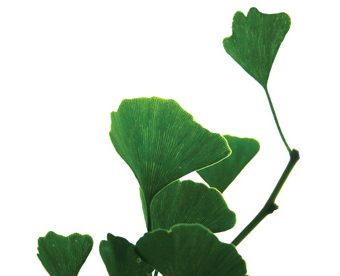Ginkgo tree links Cornell to the ancients
Shading the President’s House for more than 150 years is a magnificent male Ginkgo biloba, the oldest tree on the Hilltop and older than the college. He stands over 85 feet tall and has a crown that spreads more than 75 feet. The Iowa Conservation Commission has named him a “State Champion tree … the largest reported of [his] species growing in the State of Iowa.”
 Ginkgoes are the sole living link between the ferns and conifers and the oldest known living species of tree: their fossils show they have not changed in 270 million years. The extinction of the dinosaurs, which ate and dispersed the seeds, and some natural disasters (an ice age or two) wiped out the ginkgo’s European and American branches. Some of the latter now lie in Washington’s Ginkgo Petrified Forest State Park. One species held on tenaciously in southeastern China, where monks considered the tree divine and planted it near temples. Confucius taught under a ginkgo. From China the tree traveled to Japan and Korea, home today to a 1,100-year-old survivor, the largest ginkgo in Asia, and a Korean National Treasure. Six ginkgoes survived the atomic blast at Hiroshima.
Ginkgoes are the sole living link between the ferns and conifers and the oldest known living species of tree: their fossils show they have not changed in 270 million years. The extinction of the dinosaurs, which ate and dispersed the seeds, and some natural disasters (an ice age or two) wiped out the ginkgo’s European and American branches. Some of the latter now lie in Washington’s Ginkgo Petrified Forest State Park. One species held on tenaciously in southeastern China, where monks considered the tree divine and planted it near temples. Confucius taught under a ginkgo. From China the tree traveled to Japan and Korea, home today to a 1,100-year-old survivor, the largest ginkgo in Asia, and a Korean National Treasure. Six ginkgoes survived the atomic blast at Hiroshima.
A German working for a Dutch company in Nagasaki in the 1690s sent seeds to the Netherlands labeled “ginkgo,” a Sino-Japanese word meaning “silver apricot.” In 1784, William Hamilton of Philadelphia obtained a cutting from Japan and planted the first ginkgo, a male, on American soil. Another William Hamilton (no relation) planted Cornell’s ginkgo in 1850 when he built what is today the President’s House. Could Cornell’s tree have been a cutting from the Philadelphia tree?
A botanist called it the maidenhair tree because of the similarity of the delicate lines on its leaves to the feather-like structures of the fern of that name. This nickname probably gave rise to the tradition embraced by Cornell women and others of combing their hair under a ginkgo tree on a moonlit night. Wishes made here were bound to come true. Even more alluring was the expectation that the woman would see the face of her beloved or husband-to-be in her mirror.
Both male and female trees flower, but only fertilized females bear fruit. A male must be within 1,500 feet of a female for fertilization to occur. People say the fruit smells like rancid butter. For this reason, gardeners obtain cuttings to ensure a male tree. The first recorded female ginkgo in Europe appeared near Geneva in 1814.
In March 2010, a storm toppled an 800-year-old ginkgo at the Tsurugaoka Hachiman shrine in Japan. Visitors came from all over to pay their respects; others sent messages of condolence. Someone blogged, “Rest in peace, old one.” If only our ginkgo could speak, he might lament that the Rock receives more reverence than he and Cornellians neglect him. Alas, he can never tell us, for ginkgoes speak arboreal, a language that has roots and stems but neither vowels nor consonants and is therefore totally incomprehensible to humans.
